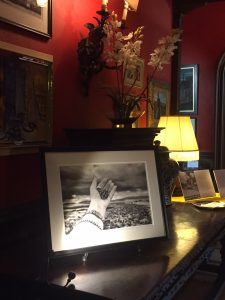
Please join us at the Evergreen Museum & Library for an exhibition entitled, An Invisible World Made Visible: The Infrared Landscapes of Phyllis Arbesman Berger. It runs through September 11, 2016 and is included with guided museum tour admission: 11am–4pm Tuesday–Friday, noon–4pm Saturday–Sunday (last tour departs at 3pm).
Visitors can expect to be transported in time, to the early 20th century when John Work and Alice Warder Garrett made Evergreen their home. Alice Warder Garrett, patroness of visual and performing arts, used Evergreen’s many spaces to showcase her interests; and 21st century visitors continue to benefit from the results of her patronage.
Phyllis Arbesman Berger‘s exhibition is transportive as well, presenting the world through a very specialized lens. Although a visit to Evergreen includes encounters with Picasso, Degas, Rodin, Dufy, Modigliani, and Haseltine, just to name of few, this exhibition is not as incongruous to Alice Warder Garrett’s vision as the title might, at first, suggest.
Evergreen Director-Curator, James Archer Abbott, has situated Berger’s photographs in juxtaposition to the permanent collection. The exhibition is partially a treasure hunt, as viewers are invited to seek the current amidst the classic; and Abbott has made sensical and sensitive connections between Berger’s infrared photographs and the paintings and sculpture that Alice so carefully chose for her own.
This is especially true in the Reading Room, the octagonal former dining room re-envisioned in 1932 as a library for John Work Garrett’s ever expanding collection of books. The room currently houses what is loosely considered the “travel” collection: decorated cloth editions detailing the history and features of countries around the world, true travel guides, such as Baedeker’s, and similar texts. The room is decorated with panels created by Miguel Covarrubias to reflect John Work Garrett’s postings in the Diplomatic Service. In this space, Abbott has featured several of Berger’s photographs reflective of specific international locales. The relationship between Covarrubias’ image of the Eiffel Tower with Berger’s is particularly striking.
Berger, who is the Photography Director for the Center of Visual Arts, has written of her own work: “I love the idea of photography as a science and as an art and infrared brings together these two elements in a most elegant way…I am an interpreter of what I see before me, much in the way a painter might analyze and experience a place, whether it is traipsing alone in the wilds of the Burren or surrounded amid crowds in the Tuilleries Gardens of Paris.”
More information can be found at http://museums.jhu.edu/evergreen.php?section=exhibitions&exhibition=infrared.
